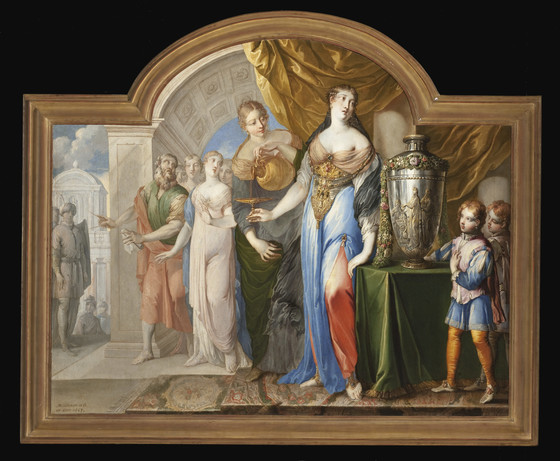Curator Notes
Isaac Moillon is a rediscovery of modern art history. Born in a large family of painters whose best-known member is, atypically, his sister, Louise Moillon, a remarkable painter of still life that, to this day, appeal to collectors of Northern paintings, Isaac achieved considerable fame in his lifetime. As the main designer of "cartons" or models for the Aubusson tapestry manufactory, he occupied a semi official position in the highly structured artistic life of seventeenth century France.
As a painter, Moillon worked for the Church (in spite of his belonging to the Reformed Faith) — one of his main commissions being the decoration of the Hotel Dieu at Beaune — and for a small group of enlightened provincial aristocrats in the regions of Auvergne and Limousin, in central France. His only recorded decoration for a hotel in Paris, on the spot currently occupied by the Bibliotheque Nationale, did not survive.
The reconstruction of his work began in the early 1980's (culminating in an exhibition and major catalogue in 2005) and has thus far yielded an original body of work whose existence challenges our established notion of classicism. While his paintings reveal subtle affinities with the works of some of his contemporaries, Laurent de la Hyre and Jacques Stella (artists represented in LACMA's collection) in particular, they are also striking for their originality and elegance. Particularly remarkable are the decorations done by Isaac Moillon in the early 1650's for various chateaus in the Auvergne. Sophonisbe Drinking Poison seems to belong to this group. The subject of Queen Sophonisba drinking poison rather than being paraded in the Roman triumph of her victor, Scipio Africanus, was much in favor in French literary circles at the time Moillon executed this painting. Plays by Jean Mairet (1634), Georges de Scudery and Pierre Corneille (1663) had made the theme popular with the public.
What links this painting to the decorations Isaac Moillon executed — also in 1653 — for the Chateau of Saint Quintin sur Sioule is not only their similar style, but also their subject illustrating heroic women: Sophonisba, Porcia (committing suicide by eating coals), and Esther fainting before Ahasuerus. The painting's striking figures, clear colors, and elegant details such as the carpet or the huge — almost neoclassic urn, evoke a form of mannerism that seems anachronistic with the date of the painting, 1653. Indeed Moillon adopts here a narrative form that is as opposed as can be imagined from the solemn and severe classicism of Poussin at the same time. It is also quite different from Moillon's own previous style at Beaune in the mid 1640s. There, Moillon's sturdier figures belong more fully to the prevalent French classical canon. The stylistic shift remains unexplained and seems to have been dictated more by the subject than by any other reason.
This very rare painting adds to the museum's important collection of seventeenth century French painting and adds a fresh, unexpected — indeed unique — note to it. There are no other paintings by the artist in any other American museum.
More...



